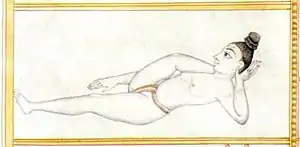Bhairavasana
Bhairavasana (Sanskrit: भैरवासन) or formidable pose, sometimes called Supta Bhairavasana (सुप्त भैरवासन),[1] is a reclining asana in hatha yoga; the variation Kala Bhairavasana (काला भैरवासन) has the body balanced on the straight leg and one arm, as in Vasiṣṭhāsana. Bhairava is one of the eight aspects of the god Shiva.[2] The pose has also been called Aṇkuśāsana (अण्कुशआसन), the elephant goad pose.

Etymology and origins

The name comes from the Sanskrit Bhairava (भैरव) meaning "terrible, formidable";[2] Kāla (काल) Bhairava, a name of the Hindu god Shiva in his aspect as the universe's destroyer;[2] and Asana (आसन, āsana) meaning "posture" or "seat".[3] Supta (सुप्त) means supine or reclining.
The pose is illustrated in the 19th century Sritattvanidhi under the name Aṇkuśāsana (अण्कुशआसन), from Sanskrit अण्कुश, an elephant goad.[4]
Description
The pose is a reclining posture with one leg stretched straight out, and the foot of the other leg behind the neck. The hands are held in prayer position in front of the chest. In the variant pose Kala Bhairavasana, the arm on the side with the bent leg is held out straight, supporting the body, while the arm on the side with the straight leg is held out, straight up.[2][5][6]
Variations
Chakorasana, from Sanskrit चकोर Chakora, a partridge, is a raised version of the same pose. The foot of the extended leg is flat on the ground; the hand on the bent-leg side is stretched straight out (in line with the shoulders) supporting the body with the palm on the ground; the other hand is stretched straight up.[2]
See also
- Durvasasana, a standing form of the pose
References
- "Supta Bhairavasana". Yogapedia. Retrieved 28 November 2018.
- Iyengar, B. K. S. (1979) [1966]. Light on Yoga. Schocken Books. pp. 296–299.
- Sinha, S. C. (1996). Dictionary of Philosophy. Anmol Publications. p. 18. ISBN 978-81-7041-293-9.
- Sjoman, Norman E. (1999). The Yoga Tradition of the Mysore Palace. Abhinav Publications. p. 69. ISBN 81-7017-389-2.
- "Bhairavasana". Yogapedia. Retrieved 28 November 2018.
- Mittra, Dharma (2002). Asanas: 708 Yoga Postures. New World Library. pp. 324, 584. ISBN 978-1-57731-402-8.
_from_Jogapradipika_1830_(detail).jpg.webp)

